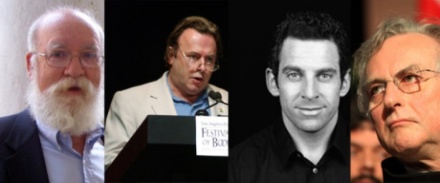
Finding the truly transformative aspects of religion isn’t this hard, but it does take a significant effort!
We humans have a remarkable ability to compartmentalize parts of our lives: to simultaneously hold conflicting sets of worldviews or perspectives. This is useful because the world Is a complex place. We need multiple tools and approaches for coping with life and pursuing wholeness. But this kind of compartmentalization can be extremely frustrating when it comes to discussing and analyzing the relationship between, say, science and religion. One example is Francis Collins, an atheist/agnostic turned Christian apologist, head of the National Institutes for Health, and a highly regarded scientist in the human genome project.
Collins is a prolific writer on science and religion, with titles like The Language of God: A Scientist Presents Evidence for Belief. But according to his own words, what ultimately resolved his search is that he was hiking and saw a really striking three-part waterfall. It reminded him of the Christian doctrine of the Trinity (God = God, Jesus, and the Holy Spirit). Boom, his searching, wondering, and struggle was done. He was a Christian.
I’d never knock this story as forming part of someone’s spiritual journey. I recognize he went through a long process of figuring out what he believes and why. But if you’re then going to become an apologist and make it your point to argue in the public sphere why Christianity is right (and for him, implicitly why other religions are “wrong”) then that story really doesn’t cut it, especially running with the scientist angle! I completely sympathize when atheists get flummoxed by such a subjective explanation of religious belief.
Some of my own views on religion align with those of two prominent personalities: Leo Tolstoy (not many seem to know he wrote extensively on religion!), and the American physicist Richard Feynman. Tolstoy described religions using a metaphor – they are each like a sack containing pearls of infinite worth mixed up with and often hidden by a lot of ashes. In other words, religion comes with its own baggage: all sorts of corruption, in-fighting, violence in the process of creating doctrine, hypocrisy, and forms of “idolatry” that infiltrate scriptures, such as nationalism, tribalism, and sexism.
My own journey resonates with this. When I read that Jesus says to “knock and the door shall be opened to you” and “search and you shall find” I think of this metaphor. It makes sense that there’s a lot of sifting and sorting to do. There are pearls to find, but it’s an ongoing process, not a quick journey that’s over all at once. Through a lot of searching over a decade or so (questioning my beliefs, exploring contemplative Christianity, living in a couple of monasteries, learning about other religions, being involved in interfaith groups), I came to see some of the pearls within Christianity, and to understand its limitations and the problem areas: the ashes.
During part of Richard Feynman’s career, he was a professor and mentor of graduate students. Some of his students struggled the conflicts between their religious Christian upbringing and the science they were learning. Feynman ultimately came to describe the challenge of the science vs. religion debate as one of being able to distinguish and preserve the wonderful moral teachings and inspiration of religion while being able to challenge specific worldviews or claims about objective, scientific reality that they make. I think this is an especially important point for prominent atheists to engage in. I think much more progress will be made extending the conversation to the pearls of religion and the many internal tools and teachings they contain to weed out the good from the bad and point to the dangers of hypocrisy and power. Many atheists are motivated by a humanist desire to decrease suffering related to religious belief, so this could be a fertile ground of exploration.
I believe Sam Harris, despite my disagreements with him on some topics, is one of these. I love his metaphor of the Moral Landscape, in which he envisions a 3-D map with many different peaks and valleys, where the peaks correspond to different ways of human flourishing and the valleys correspond to the many ways we can make ourselves and others suffer. He could contribute to the transformation of religion by focusing more on the peaks of well-being specifically within religious traditions.
As Feynman’s viewpoint alludes to, religion often makes claims about the world or universe that it isn’t qualified to and doesn’t need to make such as the idea that Earth is the center of universe, back in Galileo’s day. That was (taken to be) an important theological idea then, but come on, it’s not actually essential to Christianity. Something similar today happens over topics like evolution.
My own experience in the interfaith group Religions for Peace, exposure to monastic interfaith religious dialogue, and love for food has led me to my own metaphor. Each religion (with exceptions like Scientism) is like a culinary tradition from a nation or region of the world. Each has many things beautiful, tasty, and wonderful to offer. While foods are clearly different across the world, they are also the same in many fundamental ways (nutrition, chemistry, aesthetics and creative pursuits, etc) as well.
Each cuisine of the world also has its own types of junk food. I think the discourse on religion, science, atheism, and ethics will improve as we increasingly recognize that the world’s religions have tremendous and wonderful commonalities, and when we are also keenly aware of and open to talking about their limitations – most especially the ways that they can be and are used (or abused/warped) in ways that cause tremendous pain and suffering. It’s especially important to have a deep understanding of a religion in order to understand if negative actions or beliefs ascribed to the religion are an integral part of it or are instead a parasite, addition, or perversion of the original teachings and spirit of the religion.
On its own, I recognize that many people will find my food metaphor too simple. I look forward to getting into more depth on all of this!
As always, I welcome your thoughts and questions!





